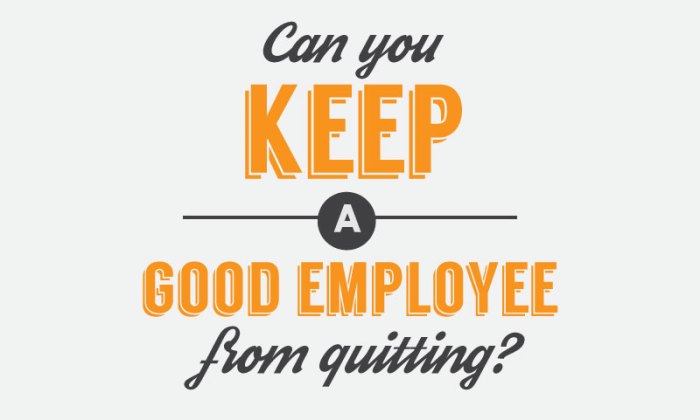How not to lose your best employee? This isn’t just about keeping good people; it’s about creating an environment where they thrive, feel valued, and want to stay. We’ll explore everything from understanding their unique needs to fostering a positive work culture and offering opportunities for growth. Discover the secrets to retaining top talent and building a team that truly excels.
This comprehensive guide dives into the multifaceted aspects of employee retention. We’ll unpack the crucial elements of understanding employee value, recognizing warning signs, addressing performance issues constructively, and cultivating a positive work environment. From communication and collaboration to growth opportunities and competitive compensation, we’ll cover it all, equipping you with practical strategies to keep your best employees engaged and motivated.
Understanding Employee Value Proposition

Attracting and retaining top talent is crucial for organizational success. Understanding the unique value each employee brings is paramount to fostering a positive and productive work environment. This involves more than just salary; it encompasses a comprehensive evaluation of their skills, contributions, and overall impact on the company’s objectives. A strong understanding of the employee value proposition allows for targeted support and development, ultimately leading to increased employee engagement and retention.Understanding employee value is not a static exercise; it’s an ongoing process that requires continuous evaluation and adaptation.
By proactively assessing and addressing individual needs, companies can foster a culture where employees feel valued, supported, and motivated to contribute their best work.
Defining a Valuable Employee
A valuable employee is one who consistently exceeds expectations and contributes significantly to the organization’s success. This goes beyond simply completing tasks; it involves proactive problem-solving, innovative thinking, and a commitment to continuous improvement. Their contributions should demonstrably align with the company’s strategic goals.
Key Characteristics of High-Performing Employees
High-performing employees exhibit several key characteristics. They are typically highly motivated, demonstrating a strong work ethic and a commitment to their roles. These individuals possess strong communication skills, enabling them to collaborate effectively with colleagues and stakeholders. Proactive problem-solving and a willingness to learn and adapt are also common traits. Finally, a strong sense of ownership and accountability is essential for high-performing employees to consistently deliver results.
Understanding Individual Employee Needs and Motivations
Recognizing the individual needs and motivations of employees is critical for maximizing their potential. Factors such as career aspirations, work-life balance preferences, and personal values play a significant role in employee satisfaction and engagement. Understanding these elements allows for the development of tailored support systems and growth opportunities, fostering a sense of belonging and appreciation. Companies that invest in understanding their employees’ needs and motivations tend to experience higher levels of employee retention and productivity.
Measuring and Tracking Employee Contributions
Measuring employee contributions requires a structured approach. Key performance indicators (KPIs) should be aligned with the company’s strategic goals. Metrics can include sales figures, project completion rates, customer satisfaction scores, and improvements in efficiency. Regular feedback sessions, both formal and informal, are crucial for tracking progress and identifying areas for improvement. By systematically tracking contributions, companies can identify high-performing individuals and ensure that their efforts are recognized and rewarded.
Framework for Assessing Overall Employee Value
A robust framework for assessing employee value involves a multi-faceted approach. It should encompass not only quantifiable metrics but also qualitative factors such as teamwork, leadership, and innovation. The assessment should consider the employee’s role within the organization, their skill set, and their impact on key performance indicators.
Keeping your top performers is crucial for any business. One key factor is recognizing when you might be unintentionally hindering their growth or, worse, making them feel trapped. Consider this: are you inadvertently living their life for them? If so, check out these 9 actionable strategies to stop living someone else’s life here. By focusing on their autonomy and career development, you’ll foster a more engaged and loyal employee, thus avoiding the risk of losing your best talent.
“A holistic approach that considers both quantitative and qualitative data provides a more comprehensive view of an employee’s value.”
This approach ensures a fair and accurate evaluation of each employee’s contributions.
Keeping your top employee happy is key, and one way to foster a positive work environment is to show genuine appreciation. Think about how you can empower them and provide opportunities for growth, like exploring new responsibilities or training. For example, encouraging a love of learning and creativity in your employees (or in your own kids!), check out some fantastic reads for 6-year-olds, like those found at best books for 6 year olds.
Ultimately, investing in your employees’ development will ensure they feel valued and motivated to stay.
Employee Value Assessment Table
| Employee Roles | Key Skills | Value Metrics |
|---|---|---|
| Sales Representative | Customer Relationship Management, Sales Negotiation, Product Knowledge | Sales Revenue, Customer Acquisition Rate, Customer Retention Rate |
| Software Developer | Coding, Problem Solving, Software Design | Number of Features Delivered, Code Quality, Project Completion Rate |
| Marketing Specialist | Content Creation, Digital Marketing, Campaign Management | Website Traffic, Lead Generation, Brand Awareness |
Recognizing Warning Signs of Potential Departure

Keeping your best employees is crucial for a thriving company. Understanding the subtle signs that an employee might be considering leaving is vital for proactive intervention and retaining valuable talent. This involves more than just performance reviews; it requires a keen eye for changes in attitude, communication, and work habits.Recognizing these warning signs allows you to address potential issues early on, potentially preventing a costly loss of experience and expertise.
This early intervention can involve simple conversations, adjustments to workload, or even a reassessment of the employee’s role to ensure they remain engaged and valued.
Common Warning Signs
Early identification of potential departure is crucial for retaining top talent. Employees may exhibit subtle changes in their behavior, communication, or work habits. These shifts can be indicators of dissatisfaction or a desire for change.
- Decreased communication frequency or quality: A significant reduction in communication, both in quantity and quality, may signal growing dissatisfaction. This could manifest as fewer interactions with colleagues, less engagement in team meetings, or delayed responses to emails and messages.
- Changes in work habits and attitude: A noticeable shift in work habits, such as decreased productivity, missed deadlines, or a reluctance to take on new projects, can be warning signs. Likewise, a noticeable change in attitude, marked by negativity, cynicism, or a lack of enthusiasm, might indicate underlying issues.
- Reduced engagement and participation: A decline in participation in company activities, social events, or team projects can indicate decreased engagement and a potential loss of interest in the workplace. This could also include a lack of enthusiasm in contributing to team discussions or brainstorming sessions.
- Increased absenteeism or lateness: An increase in absenteeism or lateness, without valid reasons, could be a symptom of dissatisfaction. This may be a subtle way of distancing themselves from the workplace or expressing their discontent.
Communication Patterns Indicating Dissatisfaction
Monitoring communication patterns is a vital aspect of recognizing potential employee departure. Changes in how an employee communicates can reveal underlying dissatisfaction.
- Negative or critical tone in communication: Employees expressing negativity, criticism, or complaining more frequently might be experiencing dissatisfaction or stress. This could manifest in complaints about work tasks, colleagues, or the overall work environment.
- Decreased willingness to collaborate: A reduced willingness to collaborate or cooperate with colleagues, or a reluctance to share knowledge, can suggest a growing sense of disconnect or dissatisfaction within the team.
- Reduced participation in team discussions: An employee who previously participated actively in team discussions might now be less engaged, indicating a potential loss of interest or a sense of disconnect from the team.
Changes in Work Habits and Attitude
Recognizing changes in work habits and attitude is crucial for timely intervention. A noticeable shift in these areas can signal a potential departure.
- Decreased productivity: A drop in productivity, missed deadlines, or an increased error rate might signal a loss of motivation or engagement.
- Decreased enthusiasm: A decrease in enthusiasm for projects or tasks, or a lack of engagement in company initiatives, could indicate dissatisfaction or a lack of interest.
- Increased negativity: A shift towards negativity, cynicism, or a general lack of positivity can be a strong indicator of dissatisfaction.
Importance of Proactive Communication and Feedback
Open communication and feedback are crucial for addressing potential issues and retaining valuable employees.
- Regular check-ins: Regular check-ins with employees to discuss their progress, challenges, and concerns are important for fostering a supportive work environment.
- Constructive feedback: Providing constructive feedback, both positive and negative, is vital for employee growth and development. This helps in identifying areas for improvement and strengthening the relationship.
- Active listening: Actively listening to employees’ concerns and feedback is essential for understanding their perspective and addressing any underlying issues.
Table of Warning Signs
| Behaviors | Possible Causes | Action Steps |
|---|---|---|
| Decreased productivity, missed deadlines | Burnout, lack of clarity, workload imbalance | Discuss workload, provide support, clarify expectations |
| Negative attitude, critical comments | Dissatisfaction, unresolved conflicts, lack of recognition | Engage in open dialogue, address concerns, provide feedback |
| Reduced participation in team activities | Feeling excluded, lack of engagement, interpersonal conflicts | Encourage participation, address potential conflicts, foster team cohesion |
Addressing Performance Issues Constructively
Keeping your top performers engaged and productive requires proactive management of performance issues. Ignoring underperformance can lead to decreased productivity, a negative impact on team morale, and ultimately, the loss of valuable employees. Constructive feedback and a supportive environment are crucial for addressing these issues effectively.Addressing performance concerns directly and supportively fosters a healthy work environment and allows for improvement.
A proactive approach to performance issues, rather than a reactive one, demonstrates respect for employees and their contributions.
Methods for Providing Constructive Feedback
Effective feedback focuses on specific behaviors and their impact, rather than general criticism. It should be delivered privately, in a calm and professional manner. Avoid accusatory language and instead use “I” statements to express your perspective and concerns. Emphasize the desired outcome and how the employee’s actions can contribute to it. For example, instead of saying “You’re always late,” try “I’ve noticed you’ve been late for the last few meetings.
This impacts our team’s ability to complete projects on time.”
Strategies for Addressing Performance Gaps
Addressing performance gaps requires a phased approach. First, clearly define the expected performance standards and ensure the employee understands them. Next, identify the root causes of the performance gap. Is it a lack of training, a misunderstanding of expectations, or a different issue entirely? This is the crucial stage of diagnosis and understanding.
Once the cause is identified, work collaboratively with the employee to develop a plan for improvement. This should involve clear expectations and timelines.
Comparing Different Approaches to Performance Improvement Plans
Performance improvement plans (PIPs) vary in their structure and focus. Some PIPs are formal, with specific metrics and deadlines. Others are more informal, focusing on coaching and support. The best approach depends on the specific situation and the employee’s needs. Formal PIPs are generally better suited for serious performance issues that have not improved despite prior feedback.
Informal approaches, on the other hand, are ideal for addressing minor issues and fostering growth.
Examples of Clear and Concise Communication Regarding Expectations
Clear communication is essential for avoiding misunderstandings. Use specific examples to illustrate expectations. For instance, instead of saying “Improve your communication skills,” say “In the last project, your feedback wasn’t incorporated into the final report. Going forward, please ensure your input is included in the final draft, preferably by [date].” Be precise about what’s expected and the desired outcome.
Creating a Supportive Environment for Improvement
A supportive environment fosters growth and encourages employees to take ownership of their development. This includes providing access to resources and support systems, such as training materials, mentors, or coaching sessions. Regular check-ins and open communication channels are critical to monitoring progress and providing ongoing support.
Performance Improvement Strategies
| Strategy | Description | Example |
|---|---|---|
| Coaching and Mentoring | Providing guidance and support to improve performance. | Pairing an experienced employee with a less experienced one. |
| Training and Development | Providing opportunities for skill enhancement. | Offering workshops or online courses to address specific knowledge gaps. |
| Clear Expectations and Feedback | Ensuring clarity on performance standards and providing regular, constructive feedback. | Regular performance reviews with clear goals and expectations. |
| Action Plans and Check-ins | Developing specific action plans and regularly checking progress. | Setting clear deadlines and monitoring progress towards goals. |
| Performance Improvement Plan (PIP) | A formal plan outlining expectations and consequences for underperformance. | A written document with specific goals, timelines, and consequences for failure to meet expectations. |
Fostering a Positive Work Environment: How Not To Lose Your Best Employee
A positive and inclusive work environment is crucial for employee retention and overall organizational success. A supportive culture fosters creativity, collaboration, and engagement, leading to higher productivity and a more enjoyable experience for everyone. A healthy work environment empowers employees to thrive both personally and professionally.A positive work culture isn’t just about the absence of negativity; it’s about actively cultivating a space where employees feel valued, respected, and empowered to contribute their best work.
This involves creating a safe space for open communication, addressing concerns promptly, and fostering a sense of belonging for all team members. Companies that prioritize this often see significant improvements in employee morale, performance, and loyalty.
Importance of a Positive and Inclusive Work Culture
A positive and inclusive work culture fosters a sense of belonging and psychological safety. Employees who feel valued and respected are more likely to be engaged, motivated, and productive. This leads to a more creative and innovative work environment. Inclusive cultures encourage diverse perspectives, leading to better problem-solving and decision-making.
Elements of a Healthy Work Environment
A healthy work environment is characterized by several key elements. Open communication, clear expectations, and respectful interactions are fundamental. Fair and consistent policies, opportunities for growth and development, and a supportive management team all contribute to a positive atmosphere. A sense of community and collaboration is crucial, as is a recognition of individual contributions.
Company Policies and Practices Promoting Well-being
Implementing policies that support employee well-being is crucial. Flexible work arrangements, such as remote work options or flexible hours, can significantly improve work-life balance. Providing resources for mental health, such as access to counseling services or employee assistance programs, demonstrates a commitment to employee well-being. Offering opportunities for professional development, like training programs or mentorship opportunities, can foster a sense of growth and advancement.
Significance of Open Communication Channels, How not to lose your best employee
Open communication channels are essential for a positive work environment. Regular team meetings, feedback mechanisms, and easily accessible communication tools enable employees to voice concerns and share ideas freely. This transparency fosters trust and understanding between management and employees.
Role of Leadership in Creating a Supportive Environment
Leadership plays a vital role in establishing a supportive environment. Leaders who demonstrate empathy, actively listen to employee concerns, and create a culture of respect and trust inspire a positive atmosphere. Their actions and communication style directly influence the overall work environment. Transparent decision-making processes and clear communication of company goals further contribute to a supportive atmosphere.
Keeping your top employee? It’s not just about offering great perks, though those help. It’s about understanding their needs, and that starts with a deep dive into your own mindset. Thinking about how you can improve your leadership skills will have a huge impact on how you treat your employees. That means truly listening and valuing their ideas, and learning the 25 things you must know get through your 20s 25 things you must know get through your 20s to be a better leader.
Ultimately, retaining your best employees comes down to fostering a supportive and engaging work environment where they feel valued and challenged. And that’s key to both their success and your business’s.
Procedure for Handling Complaints and Concerns Effectively
A well-defined procedure for handling complaints and concerns is essential. This should include a clear reporting mechanism, designated personnel to receive complaints, and a timeframe for addressing issues. Anonymous reporting options can also encourage employees to come forward with concerns without fear of retribution. The resolution process should be fair, transparent, and consistently applied.
Culture Element, Description, and Impact Table
| Culture Element | Description | Impact |
|---|---|---|
| Open Communication | Transparent and frequent communication between all levels of the organization, allowing for open feedback and discussion. | Improved employee engagement, reduced misunderstandings, and increased trust between management and employees. |
| Recognition and Appreciation | Acknowledging and celebrating employee contributions, both large and small, fostering a sense of value and accomplishment. | Increased motivation, improved morale, and enhanced job satisfaction. |
| Respectful Interactions | Promoting a culture of mutual respect, courtesy, and consideration in all interactions, regardless of roles or differences. | Creates a safe and comfortable environment, reduces conflict, and fosters positive relationships. |
| Opportunities for Growth | Providing opportunities for professional development, skill enhancement, and career advancement. | Increased employee motivation, retention, and productivity. |
Improving Communication and Collaboration
Strong communication and collaboration are cornerstones of a thriving team environment. Effective communication channels and collaborative strategies not only enhance productivity but also foster a sense of belonging and shared purpose among team members. Open lines of communication help in addressing issues promptly, preventing misunderstandings, and creating a more supportive atmosphere.Clear communication fosters trust and mutual understanding, which are essential for successful collaboration.
This leads to increased efficiency, improved problem-solving, and ultimately, better results. A collaborative environment empowers team members to leverage each other’s strengths, share knowledge, and contribute to a collective success.
Clear Communication Channels
Establishing clear communication channels is vital for efficient information flow. This involves defining the preferred methods for different types of communication, ensuring everyone understands how and when to use them. This clarity prevents confusion and ensures that crucial information reaches the right people promptly. For example, project updates might be communicated through daily stand-up meetings, while detailed reports are sent via email.
Strategies for Effective Collaboration
Several strategies can foster collaboration among team members. Promoting open dialogue, encouraging active listening, and establishing clear roles and responsibilities are key elements. Team members should feel comfortable sharing ideas and perspectives without fear of judgment. Regular team-building activities can strengthen relationships and enhance collaboration skills.
Tools and Techniques for Improving Communication
Various tools and techniques can enhance communication effectiveness. Project management software, instant messaging platforms, and video conferencing tools can streamline communication and facilitate collaboration. Using these tools ensures everyone is on the same page and can access relevant information efficiently. Furthermore, utilizing visual aids, such as presentations and diagrams, can make complex information more easily understood.
Active Listening and Empathy
Active listening is a crucial aspect of effective communication. It involves paying close attention to both verbal and nonverbal cues, reflecting back what’s been heard, and asking clarifying questions. Empathy, the ability to understand and share the feelings of another, further strengthens communication by allowing team members to connect on a deeper level and anticipate needs. This approach leads to more understanding and acceptance of diverse viewpoints, fostering a stronger sense of connection within the team.
Facilitating Productive Meetings
Effective meetings are crucial for information sharing and decision-making. To maximize productivity, meetings should have clear objectives, agendas, and assigned roles. Time management is essential, ensuring that discussions stay on track and deadlines are met. Encouraging participation from all team members and providing opportunities for questions and feedback are vital for a productive meeting.
Effective Communication Strategies and Tools
| Strategy | Description | Tools |
|---|---|---|
| Daily Stand-up Meetings | Short, focused meetings to discuss progress and address roadblocks. | Video conferencing (Zoom, Google Meet), instant messaging (Slack, Microsoft Teams) |
| Regular Team Briefings | Detailed updates on project status, challenges, and next steps. | Presentations (PowerPoint, Google Slides), shared documents (Google Docs, Microsoft Word) |
| One-on-One Check-ins | Individual meetings to address specific concerns, provide feedback, and discuss goals. | Scheduling software (Calendly), instant messaging (Slack, Microsoft Teams) |
| Collaborative Document Editing | Real-time editing and feedback on documents to ensure everyone is aligned. | Cloud-based document editors (Google Docs, Microsoft Word Online) |
| Open Forum Discussions | Designated spaces for open communication and brainstorming. | Discussion forums (Slack channels, Microsoft Teams channels) |
Providing Opportunities for Growth and Development
Investing in employee growth is not just a nice-to-have; it’s a strategic imperative. A company that prioritizes employee development fosters a culture of continuous learning, engagement, and loyalty. Employees who feel valued and empowered to advance their careers are more likely to be productive, innovative, and committed to the long-term success of the organization.Employees crave opportunities to enhance their skills and advance their careers.
When companies provide these opportunities, they demonstrate a commitment to their employees’ well-being and future. This, in turn, boosts employee morale, increases job satisfaction, and reduces turnover. Furthermore, a focus on employee development fosters a culture of continuous improvement, benefiting the entire organization.
Significance of Career Development Opportunities
Employees who see a clear path for professional growth are more engaged and motivated. Opportunities for skill enhancement and advancement demonstrate a company’s commitment to its employees’ future, leading to increased job satisfaction and reduced turnover. This proactive approach to development also prepares the company for future needs and fosters a culture of continuous learning.
Mentorship Programs and Skill-Building Initiatives
Mentorship programs, where experienced employees guide and support newer colleagues, provide invaluable support and guidance. These programs foster knowledge transfer, build relationships, and accelerate skill development. Skill-building initiatives, such as workshops, training courses, and online learning platforms, provide structured learning opportunities to develop specific skills or knowledge. They can cover technical skills, soft skills, leadership abilities, or industry-specific knowledge.
Challenging Assignments and Employee Learning
Providing challenging assignments is crucial for professional growth. Employees gain valuable experience and expand their skill sets when tasked with projects that push them beyond their comfort zones. This not only enhances their capabilities but also boosts their confidence and sense of accomplishment. Encouraging employee learning through various channels, including internal knowledge sharing, conferences, and industry events, further strengthens their professional development.
Recognizing and Rewarding Employee Achievements
Recognizing and rewarding employee achievements is essential for motivation and morale. Formal recognition programs, such as employee of the month awards, peer-to-peer recognition, and public acknowledgments, highlight accomplishments and foster a positive work environment. This approach reinforces desired behaviors and demonstrates appreciation for employee contributions. Regular feedback and performance reviews are also important aspects of acknowledging employee achievements.
Development Opportunity Table
| Development Opportunity | Description | Benefits |
|---|---|---|
| Mentorship Program | Pairing experienced employees with newer ones for guidance and support. | Improved knowledge transfer, enhanced skill development, strengthened relationships, faster career progression. |
| Skill-building Workshops | Structured training sessions focused on specific skills or knowledge areas. | Increased proficiency in technical and soft skills, enhanced job performance, improved problem-solving abilities. |
| Challenging Assignments | Projects that push employees beyond their current skill level and responsibilities. | Expanded skill set, increased confidence, deeper understanding of company processes, improved problem-solving abilities. |
| Internal Knowledge Sharing | Opportunities for employees to share their expertise and knowledge with colleagues. | Increased collaboration, cross-functional understanding, enhanced problem-solving skills, continuous learning. |
| Conferences and Industry Events | Attendance at industry events to stay updated on current trends and developments. | Expanded knowledge of industry best practices, improved networking opportunities, enhanced professional development. |
| Formal Recognition Programs | Awarding employees for outstanding achievements and contributions. | Increased employee motivation and morale, strengthened company culture, reinforced desired behaviors, boosted job satisfaction. |
Ultimate Conclusion
Ultimately, retaining your best employees isn’t about a single tactic, but a holistic approach. By focusing on understanding individual needs, fostering a positive culture, and offering continuous growth opportunities, you create an environment where employees feel valued, engaged, and motivated to contribute their best work. It’s about building a team that thrives together, and this guide offers the key to unlocking that potential.
Remember, your best employees are your greatest assets – invest in them, and they’ll invest in your success.








